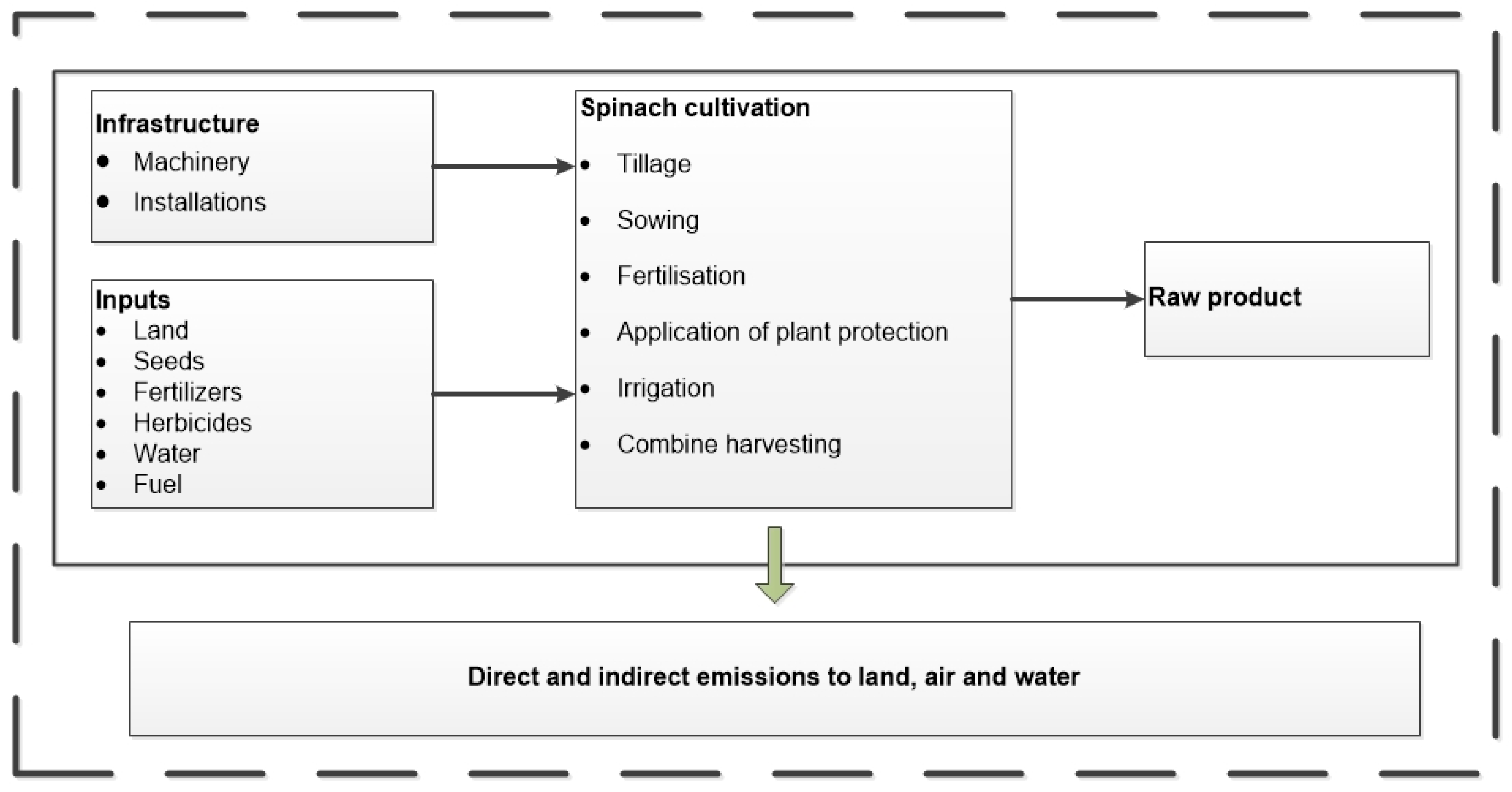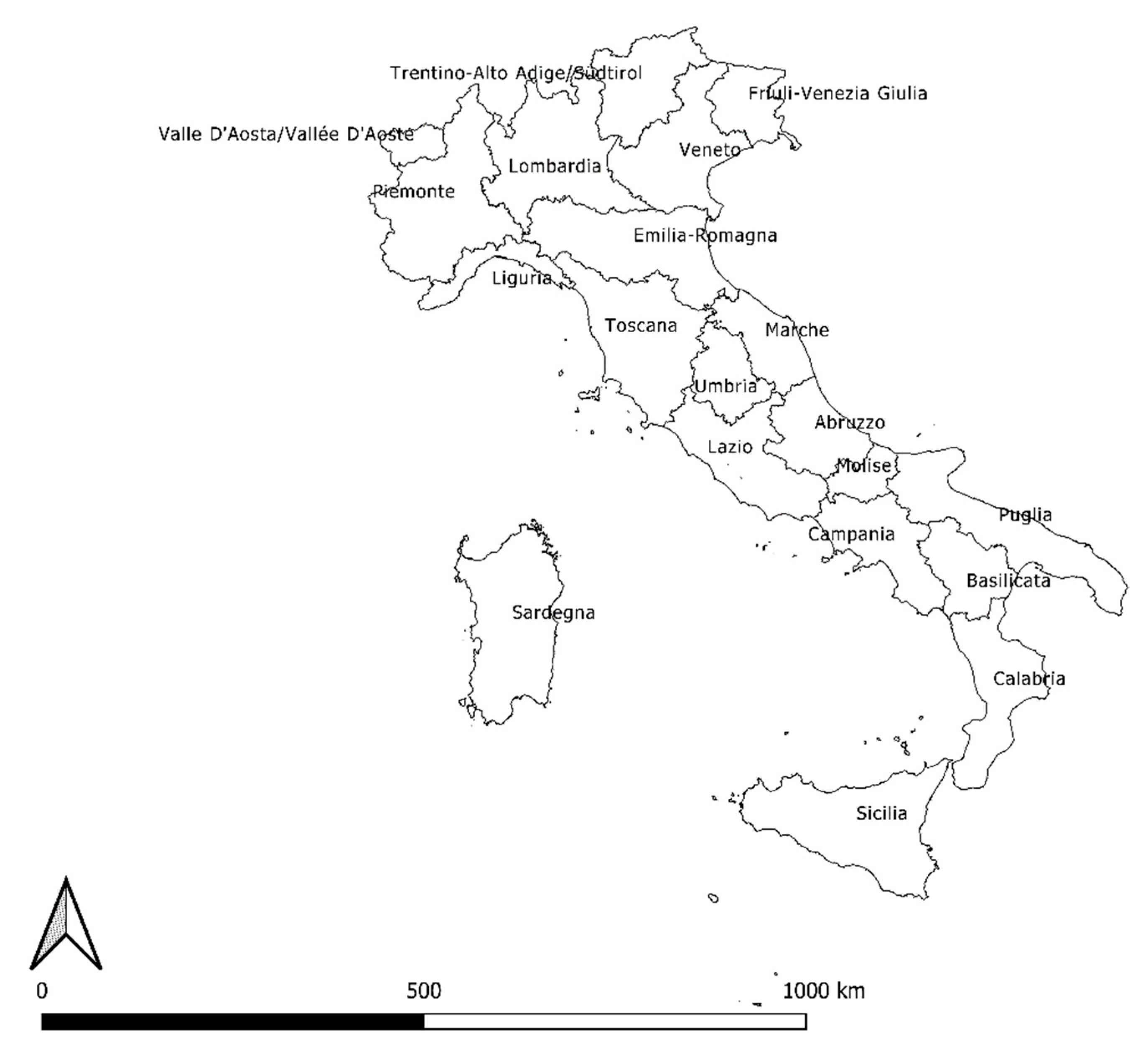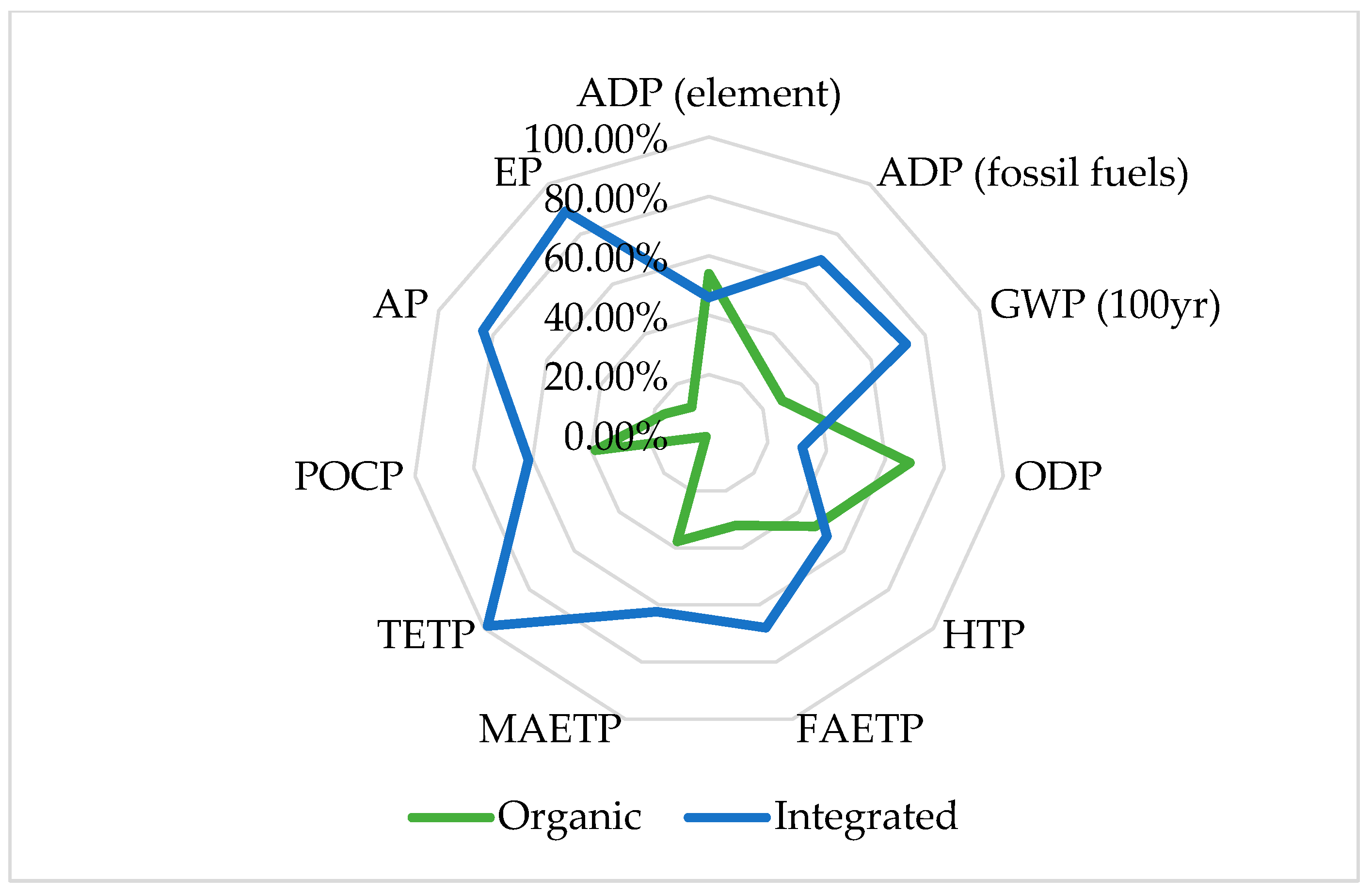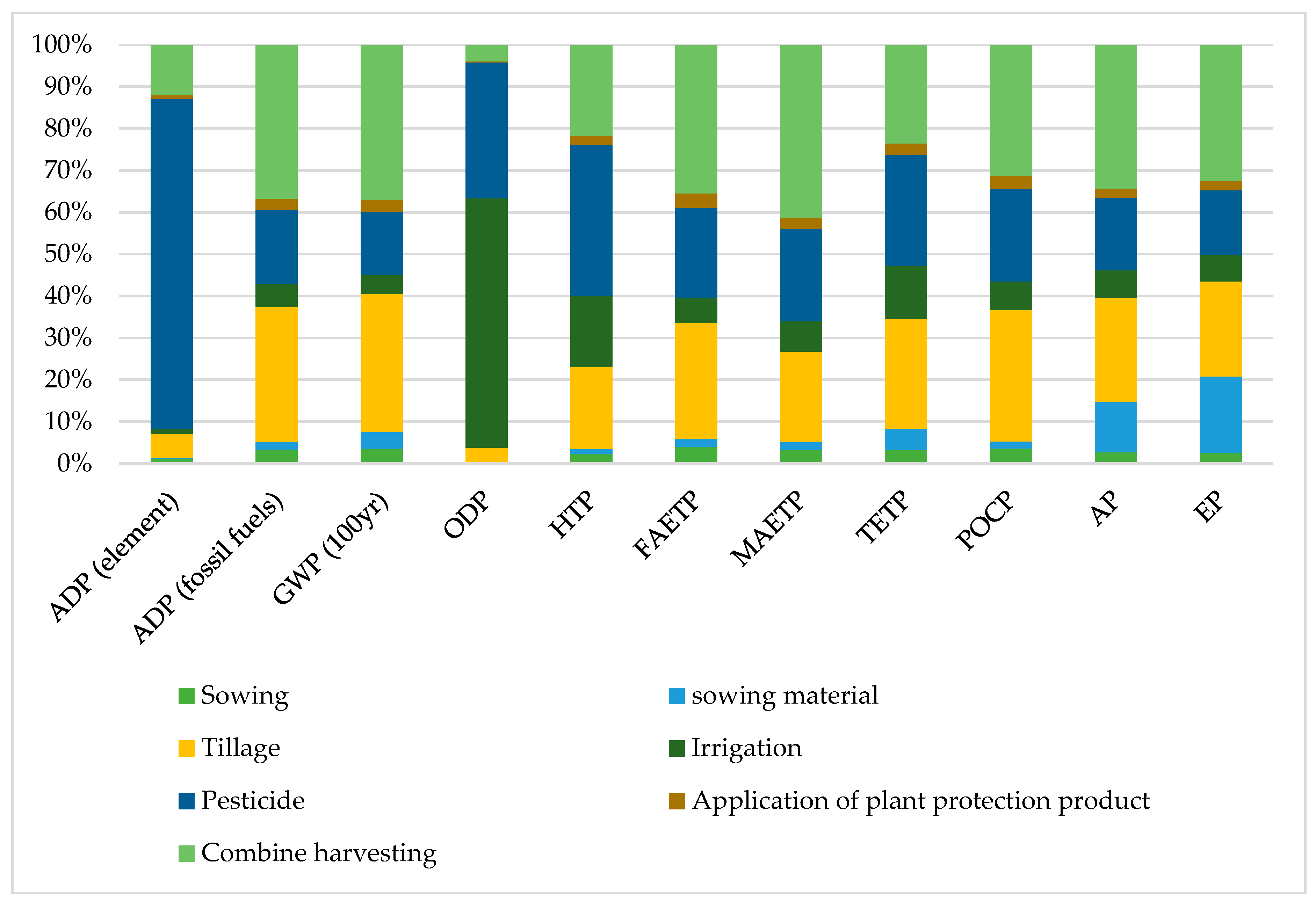Life Cycle Assessment of Spinach Produced in Central and Southern Italy
Abstract
:1. Introduction
2. Materials and Methods
2.1. Goal and Scope Definition
2.1.1. System Description and Data Quality
2.1.2. Insecticide and Pesticide Application
2.1.3. Herbicide Application
2.1.4. Fertilization
2.1.5. Irrigation
2.2. Life Cycle Inventory (LCI)
2.3. Calculations, Allocations, and Emission Models
2.4. Life Cycle Impact Assessment
3. Results
3.1. Impact Scores for Regions
3.2. Impact Scores for Different Farming Systems
3.3. Contribution Analysis
4. Discussion
4.1. Depletion of Abiotic Resources (ADP)
4.2. Global Warming (GWP)
4.3. Stratospheric Ozone Layer Depletion (ODP)
4.4. Human Toxicity (HTP)
4.5. Ecotoxicity (MAETP, FAETP, TETP)
4.6. Photochemical Ozone Creation (POCP)
4.7. Acidification (AP)
4.8. Eutrophication (EP)
5. Conclusions
Author Contributions
Funding
Institutional Review Board Statement
Informed Consent Statement
Data Availability Statement
Acknowledgments
Conflicts of Interest
References
- Tilman, D.; Cassman, K.G.; Matson, P.A.; Naylor, R.; Polasky, S. Agricultural sustainability and intensive production practices. Nature 2002, 418, 671–677. [Google Scholar] [CrossRef] [PubMed]
- Henchion, M.; Hayes, M.; Mullen, A.M.; Fenelon, M.; Tiwari, B. Future protein supply and demand: Strategies and factors influencing a sustainable equilibrium. Foods 2017, 6, 53. [Google Scholar] [CrossRef] [Green Version]
- Foley, J.A.; Ramankutty, N.; Brauman, K.A.; Cassidy, E.S.; Gerber, J.S.; Johnston, M.; Mueller, N.D.; O’Connell, C.; Ray, D.K.; West, P.C.; et al. Solutions for a cultivated planet. Nature 2011, 478, 337–342. [Google Scholar] [CrossRef] [Green Version]
- Parker, L.; Bourgoin, C.; Martinez-Valle, A.; Läderach, P. Vulnerability of the agricultural sector to climate change: The development of a pan-tropical Climate Risk Vulnerability Assessment to inform sub-national decision making. PLoS ONE 2019, 14, e0213641. [Google Scholar] [CrossRef] [Green Version]
- Shukla, P.R.; Skea, J.; Buendia, E.C.; Masson-Delmotte, V.; Pörtner, H.-O.; Roberts, D.C.; Zhai, P.; Slade, R.; Connors, S.; van Diemen, R.; et al. Climate Change and Land: An IPCC Special Report; IPCC: Geneve, Switzerland, 2019; pp. 1–864. [Google Scholar]
- Omilola, B.; Robele, S. The Central Position of Agriculture within the 2030 Agenda for Sustainable Development; IFPRI Discussion Papers; International Food Policy Research Institute (IFPRI): Washington, DC, USA, 2017; pp. 1–36. [Google Scholar]
- Miedzinski, M. Public Policy for Long-Term Societal Challenges; University of Manchester: Manchester, UK, 2015. [Google Scholar]
- Directorate-General for Communication (European Commission). Agriculture: A Partnership between Europe and Farmers; European Commission: Brussels, Belgium, 2013; p. 16.
- FAOSTAT. Food and Agriculture Organization of the United Nations Database. 2019. Available online: http://www.fao.org/faostat/en/#data/QC (accessed on 27 April 2021).
- De Cicco, A. The Fruit and Vegetable Sector in the EU—A Statistical Overview. EUROSTAT 2019. Available online: https://ec.europa.eu/eurostat/statistics-explained/index.php/The_fruit_and_vegetable_sector_in_the_EU_-_a_statistical_overview#Where_are_fruit_and_vegetables_grown_in_the_EU.3F_By_how_many_farms.3F_Over_what_area.3F (accessed on 22 April 2021).
- ISTAT, (Istituto Nazionale di Statistica). Trend in the Agricultural Economy 2019. 2020. Available online: https://www.istat.it/en/archivio/244756 (accessed on 27 April 2021).
- Roberts, J.L.; Moreau, R. Functional properties of spinach (Spinacia oleracea L.) phytochemicals and bioactives. Food Funct. 2016, 7, 3337–3353. [Google Scholar] [CrossRef]
- Pandjaitan, N.; Howard, L.R.; Morelock, T.; Gil, M.I. Antioxidant capacity and phenolic content of spinach as affected by genetics and maturation. J. Agric. Food Chem. 2005, 53, 8618–8623. [Google Scholar] [CrossRef]
- Singh, J.; Jayaprakasha, G.K.; Patil, B.S. Extraction, identification, and potential health benefits of spinach flavonoids: A review. ACS Symp. Ser. 2018, 1286, 107–136. [Google Scholar] [CrossRef]
- Batziakas, K.G.; Stanley, H.; Batziakas, A.G.; Brecht, J.K.; Rivard, C.L.; Pliakoni, E.D. Reducing postharvest food losses in organic spinach with the implementation of high tunnel production systems. Agron. Sustain. Dev. 2020, 40, 1–15. [Google Scholar] [CrossRef]
- Hasler, C.M. Functional foods: Benefits, concerns and challenges—A position paper from the American Council on Science and Health. J. Nutr. 2002, 132, 3772–3781. [Google Scholar] [CrossRef] [PubMed] [Green Version]
- Lomnitski, L.; Foley, J.F.; Grossman, S.; Ben Shaul, V.; Maronpot, R.R.; Moomaw, C.R.; Carbonatto, M.; Nyska, A. Effects of apocynin and natural antioxidant from spinach on inducible nitric oxide synthase and cyclooxygenase-2 induction in lipopolysaccharide-induced hepatic injury in rat. Pharmacol. Toxicol. 2000, 87, 18–25. [Google Scholar] [CrossRef] [PubMed]
- Nyska, A.; Lomnitski, L.; Spalding, J.; Dunson, D.B.; Goldsworthy, T.L.; Grossman, S.; Bergman, M.; Boorman, G. Topical and oral administration of the natural water-soluble antioxidant from spinach reduces the multiplicity of papillomas in the Tg.AC mouse model. Toxicol. Lett. 2001, 122, 33–44. [Google Scholar] [CrossRef]
- Rebello, C.J.; Chu, J.; Beyl, R.; Edwall, D.; Erlanson-Albertsson, C.; Greenway, F.L. Acute Effects of a Spinach Extract Rich in Thylakoids on Satiety: A Randomized Controlled Crossover Trial. J. Am. Coll. Nutr. 2015, 34, 470–477. [Google Scholar] [CrossRef] [PubMed] [Green Version]
- Sarkar, B.; Choi, H.L.; Zhu, K.; Mandal, A.; Biswas, B.; Suresh, A. Monitoring of soil biochemical quality parameters under greenhouse spinach cultivation through animal waste recycling. Chem. Ecol. 2016, 32, 407–418. [Google Scholar] [CrossRef]
- Ilari, A.; Duca, D. Energy and environmental sustainability of nursery step finalized to “fresh cut” salad production by means of LCA. Int. J. Life Cycle Assess. 2018, 23, 800–810. [Google Scholar] [CrossRef]
- Vidergar, P.; Perc, M.; Lukman, R.K. A survey of the life cycle assessment of food supply chains. J. Clean. Prod. 2021, 286, 125506. [Google Scholar] [CrossRef]
- Asioli, D.; Aschemann-Witzel, J.; Caputo, V.; Vecchio, R.; Annunziata, A.; Næs, T.; Varela, P. Making sense of the “clean label” trends: A review of consumer food choice behavior and discussion of industry implications. Food Res. Int. 2017, 99, 58–71. [Google Scholar] [CrossRef] [PubMed]
- Ericksen, P.J. What is the vulnerability of a food system to global environmental change? Ecol. Soc. 2008, 13. [Google Scholar] [CrossRef] [Green Version]
- ISO (International Organization for Standardization). Environmental Management—Life Cycle Assessment—Principles and Framework (ISO 14040:2006); ISO: Geneva, Switzerland, 2004; p. 44. [Google Scholar]
- Chiaramonti, D.; Recchia, L. Is life cycle assessment (LCA) a suitable method for quantitative CO2 saving estimations? the impact of field input on the LCA results for a pure vegetable oil chain. Biomass Bioenergy 2010, 34, 787–797. [Google Scholar] [CrossRef]
- Cooper, J.S.; Fava, J.A. Life-cycle assessment practitioner survey: Summary of results. J. Ind. Ecol. 2006, 10, 12–14. [Google Scholar] [CrossRef]
- Shiina, T.; Hosokawa, D.; Roy, P.; Orikasa, T.; Nakamura, N.; Thammawong, M. Life cycle inventory analysis of leafy vegetables grown in two types of plant factories. Acta Hortic. 2011, 919, 115–122. [Google Scholar] [CrossRef]
- Seo, Y.; Ide, K.; Kitahata, N.; Kuchitsu, K.; Dowaki, K. Environmental impact and nutritional improvement of elevated CO2 treatment: A case study of spinach production. Sustainability 2017, 9, 1854. [Google Scholar] [CrossRef] [Green Version]
- Frankowska, A.; Jeswani, H.K.; Azapagic, A. Environmental impacts of vegetables consumption in the UK. Sci. Total Environ. 2019, 682, 80–105. [Google Scholar] [CrossRef]
- Stoessel, F.; Juraske, R.; Pfister, S.; Hellweg, S. Life cycle inventory and carbon and water foodprint of fruits and vegetables: Application to a swiss retailer. Environ. Sci. Technol. 2012, 46, 3253–3262. [Google Scholar] [CrossRef] [PubMed]
- ISO (International Organization for Standardization). Environmental Management—Life Cycle Assessment—Requirements and Guidelines (ISO 14044:2006); ISO: Geneva, Switzerland, 2006. [Google Scholar]
- Fauzi, R.T.; Lavoie, P.; Sorelli, L.; Heidari, M.D.; Amor, B. Exploring the current challenges and opportunities of Life Cycle Sustainability Assessment. Sustainability 2019, 11, 636. [Google Scholar] [CrossRef] [Green Version]
- Margni, M.; Rossier, D.; Crettaz, P.; Jolliet, O. Life cycle impact assessment of pesticides on human health and ecosystems. Agric. Ecosyst. Environ. 2002, 93, 379–392. [Google Scholar] [CrossRef]
- Product Category Rules (PCR). Arable and Vegetable Crops. 2020. Available online: https://test1.environdec.com/PCR/Detail/?Pcr=16577 (accessed on 21 April 2021).
- Zampori, L.; Pant, R. Suggestions for Updating the Product Environmental Footprint (PEF) Method; Office of the European Union: Luxembourg, 2019; ISBN 9789276006541.
- Guinée, J.B.; Gorrée, M.; Heijungs, R.; Huppes, G.; Kleijn, R.; de Koning, A.; van Oers, L.; Wegener Sleeswijk, A.; Suh, S.; Udo de Haes, H.A.; et al. Handbook on Life Cycle Assessment. Operational Guide to the ISO Standards. I: LCA in Perspective. IIa: Guide. IIb: Operational Annex. III: Scientific Background; Kluwer Academic Publishers: Dordrecht, The Netherlands, 2002; ISBN 1-4020-0228-9. [Google Scholar]
- Van Oers, L.; Guinée, J. The Abiotic Depletion Potential: Background, Updates, and Future. Resources 2016, 5, 16. [Google Scholar] [CrossRef]
- Acero, A.P.; Rodriguez, C.; Ciroth, A. LCIA Methods: Impact Assessment Methods in Life Cycle Assessment and Their Impact Categories. 2017, pp. 1–23. Available online: https://www.openlca.org/wp-content/uploads/2015/11/LCIA-METHODS-v.1.5.4.pdf (accessed on 29 April 2021).
- Pré Simapro Database Manual. 2014, pp. 3–48. Available online: https://simapro.com/wp-content/uploads/2020/10/DatabaseManualMethods.pdf (accessed on 14 June 2021).
- Huang, J.; Mendoza, B.; Daniel, J.S.; Nielsen, C.J.; Rotstayn, L.; Wild, O. Anthropogenic and natural radiative forcing. In Climate Change 2013 the Physical Science Basis: Working Group I Contribution to the Fifth Assessment Report of the Intergovernmental Panel on Climate Change; Stocker, T.F., Qin, D., Plattner, G.-K., Tignor, M., Allen, S.K., Boschung, J., Nauels, A., Xia, Y., Bex, V., Midgley, P., Eds.; Cambridge University Press: Cambridge, UK; New York, NY, USA, 2013; Volume 9781107057, pp. 659–740. ISBN 9781107415324. [Google Scholar]
- Shine, K.P. The global warming potential-the need for an interdisciplinary retrial. Clim. Chang. 2009, 96, 467–472. [Google Scholar] [CrossRef] [Green Version]
- Fahey, D.; Newman, P.A.; Pyle, J.A.; Safari, B.; Chipperfield, M.P.; Karoly, D.; Kinnison, D.E.; Ko, M.; Santee, M.; Doherty, S.J. Scientific Assessment of Ozone Depletion: 2018. In Proceedings of the Global Ozone Research and Monitoring Project-Report No. 58; WMO (World Meteorological Organization): Geneva, Switzerland, 2018; pp. 1–588. [Google Scholar]
- Huijbregts, M.A.J.; Thissen, U.; Guinée, J.B.; Jager, T.; Kalf, D.; Van De Meent, D.; Ragas, A.M.J.; Wegener Sleeswijk, A.; Reijnders, L. Priority assessment of toxic substances in life cycle assessment. Part I: Calculation of toxicity potentials for 181 substances with the nested multi-media fate, exposure and effects model USES-LCA. Chemosphere 2000, 41, 541–573. [Google Scholar] [CrossRef]
- Hertwich, E.G.; Mateles, S.F.; Pease, W.S.; McKone, T.E. Human Toxicity Potentials for Life Cycle Assessment and Toxics Release Inventory Risk Screening. Environ. Toxicol. Chem. 2001, 20, 928–939. [Google Scholar] [CrossRef]
- Van Zelm, R.; Huijbregts, M.A.J.; Van De Meent, D. USES-LCA 2.0-a global nested multi-media fate, exposure, and effects model. Int. J. Life Cycle Assess. 2009, 14, 282–284. [Google Scholar] [CrossRef]
- Derwent, R.G.; Jenkin, M.E.; Saunders, S.M.; Pilling, M.J. Photochemical ozone creation potentials for organic compounds in northwest Europe calculated with a master chemical mechanism. Atmos. Environ. 1998, 32, 2429–2441. [Google Scholar] [CrossRef]
- Jenkin, M.E.; Hayman, G.D. Photochemical ozone creation potentials for oxygenated volatile organic compounds: Sensitivity to variations in kinetic and mechanistic parameters. Atmos. Environ. 1999, 33, 1275–1293. [Google Scholar] [CrossRef]
- Huijbregts, M. Life-Cycle Impact Assessment of Acidifying and Eutrophying Air Pollutants; University of Amsterdam: Amsterdam, The Netherlands, 1999; p. 40. [Google Scholar]
- Theurl, M.C.; Hörtenhuber, S.J.; Lindenthal, T.; Palme, W. Unheated soil-grown winter vegetables in Austria: Greenhouse gas emissions and socio-economic factors of diffusion potential. J. Clean Prod. 2017, 151, 134–144. [Google Scholar] [CrossRef] [Green Version]
- Galloway, J.N.; Cowling, E.B. Reactive nitrogen and the world: 200 Years of change. Ambio 2002, 31, 64–71. [Google Scholar] [CrossRef]
- Arsenovic, P.; Damiani, A.; Rozanov, E.; Funke, B.; Stenke, A.; Peter, T. Reactive nitrogen (NOy) and ozone responses to energetic electron precipitation during Southern Hemisphere winter. Atmos. Chem. Phys. 2019, 19, 9485–9494. [Google Scholar] [CrossRef] [Green Version]
- Ahmed, M.; Rauf, M.; Mukhtar, Z.; Saeed, N.A. Excessive use of nitrogenous fertilizers: An unawareness causing serious threats to environment and human health. Environ. Sci. Pollut. Res. 2017, 24, 26983–26987. [Google Scholar] [CrossRef] [PubMed]






| Insecticide (Active Ingredient) | Target |
|---|---|
| Ethofenprox | Aphids and bugs |
| Indoxacarb | Lepidopteran larvae |
| Chlorantraniliprole | Butterflies and moth |
| Bacillus Thuringensis (bioinsecticide) | Lepidopteran larvae |
| Iron phosphate | Slugs |
| Fungicide (active ingredient) | |
| Cymoxanil (Pure or with copper) | Mildew |
| Dimetomorph + Pyraclostrobin | Mildew |
| Boscalid + Pyraclostrobin | Mildew and Botrytis |
| Propamocarb | Mildew |
| Boscalid | Powdery mildew |
| Insecticide | Target |
|---|---|
| Spinosad | Lepidopteran larvae |
| Fungicide | |
| Copper oxychloride | Mildew |
| Sulphur | Powdery mildew |
| Process/Material. | Unit | Value (Integrated Cultivation) | Value (Organic Cultivation) |
|---|---|---|---|
| Land surface | ha | 2.60 × 10−4 | 2.54 × 10−4 |
| Water for irrigation | m3 | 2.24 × 10−3 | 1.19 × 10−4 |
| Water for fertilizer/treatment | L | 1.38 | 7.83 × 10−1 |
| Quantity of seed/sowing material | kg | 3.89 × 10−3 | 3.81 × 10−3 |
| Operations | |||
| Sowing | ha | 2.60 × 10−4 | 2.54 × 10−4 |
| Rolling | ha | 2.60 × 10−4 | 2.54 × 10−4 |
| Ploughing | ha | 2.60 × 10−4 | 2.54 × 10−4 |
| Rotary harrow | ha | 9.91 × 10−5 | 2.54 × 10−4 |
| Harrowing | ha | 1.38 × 10−4 | 2.54 × 10−4 |
| Weeding | ha | 1.31 × 10−4 | |
| Milling | ha | 8.07 × 10−6 | |
| Fertilization | ha | 6.37 × 10−4 | |
| Phytosanitary defence | ha | 9.81 × 10−4 | 1.36 × 10−3 |
| Harvesting | ha | 1.27 × 10−4 | 2.54 × 10−4 |
| Vertical cutter | ha | 1.49 × 10−4 | |
| Fertilizer | |||
| Ammonium sulphate (27) | kg | 7.06 × 10−4 | |
| Calcium nitrate + Copper (26.5 Cu) | kg | 1.32 × 10−5 | |
| Bio stimulants | L | 7.88 × 10−4 | |
| Ammonium nitrate (34) | kg | 2.58 × 10−4 | |
| Ammonium nitrate (27) | kg | 2.42 × 10−4 | |
| Entec (26) | kg | 4.84 × 10−4 | |
| Simple superphosphate (0:19) | kg | 6.78 × 10−4 | |
| NPK and YaraMila Bulstar (12:12:17) | kg | 3.47 × 10−3 | |
| Digestate (Organic) | kg | 5.17 × 10−1 | |
| Golden Fertil Premium (10:10:15) | kg | 1.36 × 10−3 | |
| Gran NPK (11:22:16) | kg | 3.23 × 10−4 | |
| Entec (25:15) | kg | 9.69 × 10−4 | |
| Monoammonium phosphate (12:52) | kg | 3.23 × 10−4 | |
| Diammonium phosphate (18:46) | kg | 3.57 × 10−2 | |
| Urea/Entec (46) | kg | 3.61 × 10−2 | |
| Calcium nitrate | kg | 1.90 × 10−2 | |
| Herbicide | |||
| S-metolachlor | kg | 4.45 × 10−5 | |
| Metamitron | kg | 4.06 × 10−4 | |
| Lenacil | kg | 1.09 × 10−4 | |
| Phenmedipham | kg | 3.44 × 10−5 | |
| Quizalofop-p-ethyl | kg | 2.23 × 10−5 | |
| Propaquizafop | kg | 6.44 × 10−5 | |
| Cycloxydim | kg | 1.29 × 10−5 | |
| Insecticide | |||
| Ethofenprox | kg | 5.08 × 10−5 | |
| Indoxacarb | kg | 2.35 × 10−6 | |
| Chlorantraniliprole | kg | 1.81 × 10−5 | |
| Iron phosphate | kg | 6.61 × 10−4 | |
| Spinosad | L | 3.75 × 10−4 | |
| Fungicide | |||
| Cymoxanil (Pure) | kg | 5.10 × 10−5 | |
| Cymoxanil (with Cu) | kg | 5.22 × 10−5 | |
| Dimetomorph + Pyraclostrobin | kg | 5.18 × 10−5 | |
| Propamocarb | kg | 1.53 × 10−5 | |
| Boscalid | kg | 2.30 × 10−5 | |
| Copper oxychloride | kg | 3.83 × 10−4 | |
| Sulphur | kg | 1.28 × 10−3 |
| Impact Category | Acronym | Description |
|---|---|---|
| Abiotic Depletion Potential (elements) [38] Abiotic Depletion Potential (fossil fuel) [38] | ADP (E) ADP (FF) | Abiotic depletion is concerned with the protection of human welfare, human health, and ecosystem health. This impact category indicator is related to the consumption of non-biological resources such as minerals and fossil fuels on a global scale as it measures the scarcity of a substance over time [39,40]. |
| Global Warming Potential 100 yr [41] | GWP | The noticeable change in global temperatures due to the emission of greenhouse gases (GHGs) mainly through anthropogenic activities has become a critical environmental concern necessitating in-depth investigations [39,40]. GWP is a method for comparing the climate effects of emissions of different GHGs like CO2, CH4, and N2O [42]. |
| Stratospheric Ozone Layer Depletion Potential [43] | ODP | Depleting the ozone layer due to anthropogenic emissions of ozone-depleting substances such as CFCs, halogens, and HCFCs causes a larger fraction of UV-B radiation to reach the earth’s surface. This radiation can have harmful effects on human health, animal health, terrestrial and aquatic ecosystems, biochemical cycles, and materials [39,40]. |
| Human Toxicity Potential [44] | HTP | HTP is concerned with the toxic effects of chemical substances on humans. It is a calculated index that reflects the potential harm of a unit of chemical released into the environment. It also depends on both the inherent toxicity of a compound and its potential dose. These harmful chemicals such as Arsenic, Na2Cr2O7, and HF can have a carcinogenic effect in humans when emitted into air or water [39,40,45]. |
Ecotoxicity
| FAETP MAETP TETP | Environmental toxicity is measured as three separate impact categories: freshwater ecotoxicity, marine ecotoxicity, and terrestrial ecotoxicity, which examine the impact on freshwater, marine, and land, respectively. Ecotoxicity is due to emissions of toxic substances such as heavy metals to air, water, and soil. Ecotoxicity potentials are calculated with the USES-LCA, which is a multi-media fate, exposure, and effects model [39,40,46]. |
| Photochemical Ozone Creation Potential [47,48] | POCP | Photochemical ozone is formed by the reaction of volatile organic compounds and NOx in the presence of heat and sunlight and is harmful to human health and ecosystems and may potentially damage crops. The impact category depends largely on the amounts of CO, SO2, NO, NH4, and NMVOC (non-methane volatile organic compounds) [39,40]. |
| Acidification Potential [49] | AP | Some emissions from anthropogenic activities can reduce pH due to the acidifying effects in water and soil systems. Acidifying substances cause a wide range of impacts on soil, groundwater, surface water, organisms, ecosystems, and materials consequently, decreasing biodiversity and damaging the quality of ecosystems. Gases with high acidifying potential include NH3, nitrogen oxides (NOx), and Sulphur oxides (SOx) [39,40]. |
| Eutrophication Potential [49] | EP | Eutrophication includes all impacts due to the accumulation of macro-nutrients in the ecosystem caused by emissions of nutrients such as NH3, [NO3]−, NOx, and P to air, water, and soil, which could result in abnormal productivity [39,40]. |
| Impact Category | Central (Average) | Central (Std. Dev.) | Southern (Average) | Southern (Std. Dev.) |
|---|---|---|---|---|
| ADP (E) (kg Sb eq.) | 5.19 × 10−6 | 5.47 × 10−6 | 4.28 × 10−6 | 3.59 × 10−6 |
| ADP (FF) (MJ) | 10.80 | 58.56 | 10.21 | 58.56 |
| GWP (kg CO2 eq.) | 0.56 | 0.61 | 0.47 | 0.43 |
| ODP (kg CFC-11 eq.) | 3.40 × 10−8 | 3.96 × 10−8 | 2.75 × 10−8 | 2.64 × 10−8 |
| HTP (kg 1,4-DB eq.) | 9.27 × 10−2 | 1.01 × 10−1 | 7.68 × 10−2 | 6.87 × 10−2 |
| FAETP (kg 1,4-DB eq.) | 5.87 × 10−2 | 6.23 × 10−2 | 4.98 × 10−2 | 4.68 × 10−2 |
| MAETP (kg 1,4-DB eq.) | 184.26 | 203.53 | 156.90 | 161.38 |
| TETP (kg 1,4-DB eq.) | 2.92 × 10−3 | 3.97 × 10−3 | 2.54 × 10−3 | 3.53 × 10−3 |
| POCP (kg C2H4 eq.) | 9.06 × 10−5 | 9.66 × 10−5 | 7.59 × 10−5 | 6.77 × 10−5 |
| AP (kg SO2 eq.) | 1.04 × 10−2 | 1.01 × 10−2 | 8.95 × 10−3 | 7.80 × 10−3 |
| EP (kg PO43− eq.) | 5.46 × 10−3 | 5.86 × 10−3 | 4.61 × 10−3 | 4.18 × 10−3 |
| Impact Category | Unit | Organic Farming | Integrated Farming |
|---|---|---|---|
| ADP (elements) | kg Sb eq. | 2.11 × 10−6 | 1.80 × 10−6 |
| ADP (fossil fuels) | MJ | 1.02 | 1.79 |
| GWP (100 yr) | kg CO2 eq. | 0.075 | 0.20 |
| ODP (steady state) | kg CFC-11 eq. | 2.20 × 10−8 | 1.02 × 10−8 |
| HTP (inf.) | kg 1,4-DB eq. | 3.58 × 10−2 | 3.97 × 10−2 |
| FAETP (inf.) | kg 1,4-DB eq. | 1.37 × 10−2 | 2.91 × 10−2 |
| MAETP (inf.) | kg 1,4-DB eq. | 49.10 | 81.36 |
| TETP (inf.) | kg 1,4-DB eq. | 2.91 × 10−5 | 2.13 × 10−3 |
| POCP | kg C2H4 eq. | 2.71 × 10−5 | 4.31 × 10−5 |
| AP | kg SO2 eq. | 6.35 × 10−4 | 3.26 × 10−3 |
| EP | kg PO43− eq. | 1.79 × 10−4 | 1.48 × 10−3 |
Publisher’s Note: MDPI stays neutral with regard to jurisdictional claims in published maps and institutional affiliations. |
© 2021 by the authors. Licensee MDPI, Basel, Switzerland. This article is an open access article distributed under the terms and conditions of the Creative Commons Attribution (CC BY) license (https://creativecommons.org/licenses/by/4.0/).
Share and Cite
Foppa Pedretti, E.; Boakye-Yiadom, K.A.; Valentini, E.; Ilari, A.; Duca, D. Life Cycle Assessment of Spinach Produced in Central and Southern Italy. Sustainability 2021, 13, 10001. https://doi.org/10.3390/su131810001
Foppa Pedretti E, Boakye-Yiadom KA, Valentini E, Ilari A, Duca D. Life Cycle Assessment of Spinach Produced in Central and Southern Italy. Sustainability. 2021; 13(18):10001. https://doi.org/10.3390/su131810001
Chicago/Turabian StyleFoppa Pedretti, Ester, Kofi Armah Boakye-Yiadom, Elena Valentini, Alessio Ilari, and Daniele Duca. 2021. "Life Cycle Assessment of Spinach Produced in Central and Southern Italy" Sustainability 13, no. 18: 10001. https://doi.org/10.3390/su131810001
APA StyleFoppa Pedretti, E., Boakye-Yiadom, K. A., Valentini, E., Ilari, A., & Duca, D. (2021). Life Cycle Assessment of Spinach Produced in Central and Southern Italy. Sustainability, 13(18), 10001. https://doi.org/10.3390/su131810001








